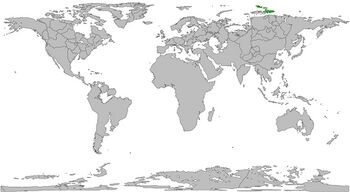East Sevaya Zemla
This article is incomplete because it is pending further input from participants, or it is a work-in-progress by one author. Please comment on this article's talk page to share your input, comments and questions. Note: To contribute to this article, you may need to seek help from the author(s) of this page. |
Democratic Republic of Sevaya Zemla
| |
|---|---|
|
Flag | |
 | |
| Capital and largest city | East Sakia |
| Official languages |
|
| Religion |
|
| Demonym(s) | East Sevayan |
| Government | Unitary Premist Republic |
• Premier | Toguray Kovalyov |
• Surrogate Premier | Mefodiy Burdusov |
• Minister of the Exterior | Irereney Kyulyumyakhtirova |
| Legislature | National Assembly |
| Area | |
• Total | 68,852 km2 (26,584 sq mi) (76th) |
| Population | |
• 3000 census | 994,505 (70th) |
• Density | 14.4/km2 (37.3/sq mi) (69th) |
| GDP (PPP) | 3000 estimate |
• Total | $14.25 billion (73rd) |
• Per capita | $14,329 (72nd) |
| GDP (nominal) | 3000 estimate |
• Total | $2.169 billion (76th) |
• Per capita | $2,181 (75th) |
| Gini (3000) | 40.6 medium (42nd (tie)) |
| HDI (3000) | 0.656 medium (62nd) |
| Currency | East Sevayan Ruble (ESR) |
| Time zone | UTC+7 (East Sevayan Standard Time) |
East Sevaya Zemla (ESZ), officially the Democratic Republic of Sevaya Zemla, is a nation in northern Asia. It is an island nation with a coast with the Sevaya Channel to the west, the Taymir Channel to the south, the Laptev Sea to the east, the Arctic Ocean to the north, and the Sevayan Sea to the northwest.
ESZ ranks high in civil liberties, moderately high in HRC-FS human rights, and high in political freedom. There are no restrictions on political freedom and all HRC-FS human rights are followed with exceptions in the prison system. The political system of ESZ is considered one of the most diverse in the world, consisting of six major and 14 minor political parties, none of which have held an outright majority in the National Assembly.
Much like West Sevaya Zemla, the East Sevayan economy relies on the Golan economy to survive. Referendums asking whether to join Gola or not have shown increasing support for the proposition while the proposition to merge with West Sevaya Zemla have shown decreasing support. It is estimated that if ESZ does not join Gola or WSZ or find alternative economic support within the next five years, ESZ will suffer a severe economic depression.
Etymology
Sevaya Zemla litarlly translates to Northern Land in Shan. The northern islands of East Sevaya Zemla were first named this in the 1900s. The country of Sevaya Zemla split in 2884 after a short civil war which created the east and west. The name was extended to the collective islands of East and West Sevaya Zemla.
